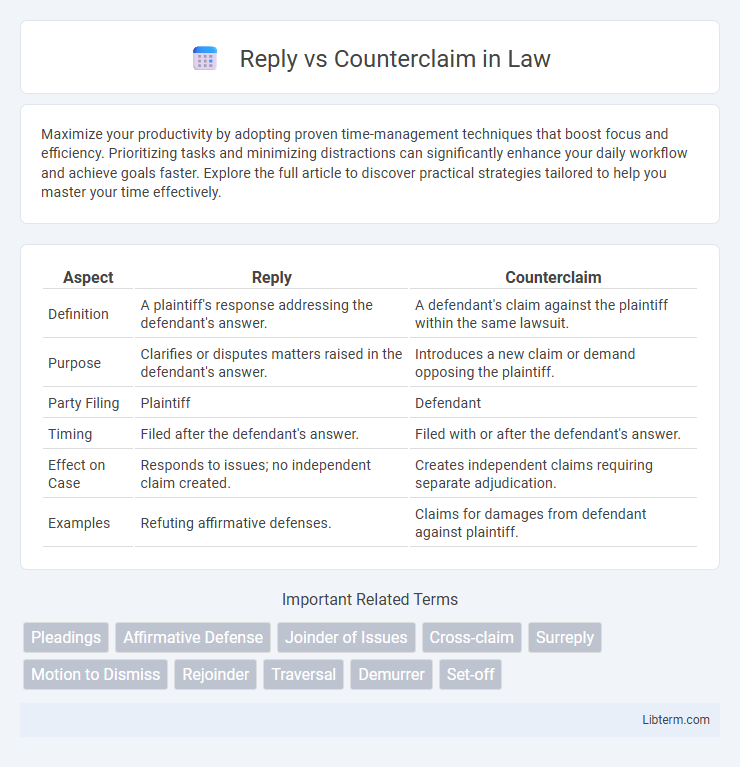Maximize your productivity by adopting proven time-management techniques that boost focus and efficiency. Prioritizing tasks and minimizing distractions can significantly enhance your daily workflow and achieve goals faster. Explore the full article to discover practical strategies tailored to help you master your time effectively.
Table of Comparison
| Aspect | Reply | Counterclaim |
|---|---|---|
| Definition | A plaintiff's response addressing the defendant's answer. | A defendant's claim against the plaintiff within the same lawsuit. |
| Purpose | Clarifies or disputes matters raised in the defendant's answer. | Introduces a new claim or demand opposing the plaintiff. |
| Party Filing | Plaintiff | Defendant |
| Timing | Filed after the defendant's answer. | Filed with or after the defendant's answer. |
| Effect on Case | Responds to issues; no independent claim created. | Creates independent claims requiring separate adjudication. |
| Examples | Refuting affirmative defenses. | Claims for damages from defendant against plaintiff. |
Understanding Replies and Counterclaims: Key Differences
A reply is a plaintiff's response to a defendant's counterclaim, addressing points raised in the counterclaim to clarify or refute allegations. A counterclaim is a defendant's assertion against the plaintiff, effectively turning the tables by introducing new claims within the same lawsuit. Understanding these distinctions is crucial for legal strategy, as replies directly respond to counterclaims while counterclaims introduce separate grounds for litigation.
What Is a Reply in Legal Proceedings?
A reply in legal proceedings is a formal written response filed by the plaintiff addressing new facts or defenses raised in the defendant's answer or counterclaim. It allows the plaintiff to clarify points, contest new allegations, and reinforce their position before the court. Unlike a counterclaim, which asserts new claims against the plaintiff, a reply specifically responds to issues introduced by the defendant.
Defining a Counterclaim: Purpose and Scope
A counterclaim is a legal assertion made by a defendant against the plaintiff, challenging the original claim and introducing new facts or legal reasons for relief. Its purpose is to directly oppose the plaintiff's allegations, potentially reducing or extinguishing liability while expanding the scope of the lawsuit. Defining the counterclaim clearly within court documents is essential for framing the issues and ensuring comprehensive judicial consideration.
Procedural Steps for Filing a Reply
Filing a reply to a counterclaim typically requires the plaintiff to respond within the timeframe set by local court rules, often 21 to 30 days after service of the counterclaim. The reply must address specific allegations raised in the counterclaim and can assert new defenses or admissions related to those issues. Failure to timely file a reply may result in the counterclaim being treated as uncontested, impacting the plaintiff's ability to dispute the counterclaim's merits during litigation.
Procedural Steps for Filing a Counterclaim
Filing a counterclaim begins with the defendant responding to the plaintiff's complaint by submitting a formal answer that includes the counterclaim. The counterclaim must be filed within the same deadline as the answer, typically 20 to 30 days after service of the complaint, depending on jurisdiction. Specific procedural requirements include clearly stating the facts and legal grounds for the counterclaim and serving a copy to the opposing party to ensure proper notice and opportunity to respond.
Legal Requirements: Reply vs Counterclaim
A reply addresses assertions made in a defendant's counterclaim and must be filed within the time frame set by the court rules, typically 21 to 30 days after service of the counterclaim. A counterclaim is a responsive pleading that asserts a claim against the original plaintiff, subject to specific legal requirements such as proper jurisdiction, subject matter relevance, and compliance with procedural rules under the Federal Rules of Civil Procedure Rule 13 or state equivalents. Failure to timely file a reply or properly assert a counterclaim may result in waiver of rights or default judgments.
Strategic Importance of Replies in Litigation
Replies in litigation serve as critical tools for addressing and clarifying issues raised in counterclaims, ensuring that a plaintiff's position is clearly articulated and defensible. Strategically, a well-crafted reply can preemptively neutralize defenses, reinforce affirmative claims, and shape the court's understanding of key legal and factual disputes. Effective use of replies enhances case management, influences dispute resolution outcomes, and strengthens the litigant's overall procedural posture.
How Counterclaims Influence Legal Outcomes
Counterclaims significantly influence legal outcomes by allowing defendants to assert their own claims against plaintiffs, thereby potentially reducing or negating the plaintiff's recovery. The presence of a counterclaim can shift the focus of the litigation, encouraging settlements or altering the judge's or jury's perception of liability and damages. Courts consider the merits of counterclaims alongside the original complaint, which can result in a more balanced resolution or impact the final judgment in a case.
Common Mistakes When Drafting Replies and Counterclaims
Common mistakes when drafting replies and counterclaims often include failing to address all points raised in the opposing party's pleadings, which can result in waived defenses or admissions. Another frequent error is improperly pleading counterclaims without meeting the requisite legal standards for subject matter jurisdiction or timely filing, potentially leading to dismissal. Legal practitioners also commonly err by not clearly distinguishing between admissions, denials, and affirmative defenses, thereby weakening their position in litigation.
Best Practices for Managing Replies and Counterclaims
Effectively managing replies and counterclaims requires clear organization and precise documentation to ensure all parties' arguments are addressed comprehensively. Best practices include timely filing of responses according to jurisdictional deadlines, explicitly admitting or denying each allegation to avoid ambiguity, and presenting counterclaims with supporting evidence to strengthen the defense. Utilizing legal software for tracking deadlines and drafting standardized templates can enhance accuracy and efficiency throughout the litigation process.
Reply Infographic

 libterm.com
libterm.com